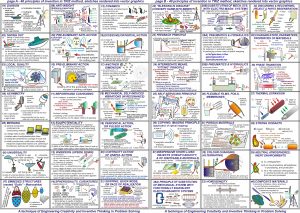For product design engineers. The 40 TRIZ Principles are the solutions to solve the “TRIZ contradictions” in product design problem-solving or to highlight other approaches during your product design brainstorming sessions.
Contents
This article focuses on the 40 triz principles to be used with or without the TRIZ methodology. Refer to TRIZ methods, tips, and tools at the end of this article.
The 40 TRIZ Principles
As these are translations from Russian -that may vary from book to book-, we have taken the most commonly used terminology, and we have regrouped the triz principles by family.
Note: we added complementary principles and technologies in the following chapter.
Highlighted in green: principles of high interest & frequent usage in Product Design
Different Assembly
This family regroups all means of assembling the components or parts differently. Clearly to be applied during the design choices.
| examples | our comments | |||
| #1 | Segmentation | Divide an object into independent parts |  | Good to solve a tech problem or source a component of the shelf, but may lead to complexity & additional costs |
| #2 | Taking out | Separate an interfering part or property from an object, or single out the only necessary part or property of an object |  | can be very effective, but product intent must be clear to eventually cut into the product specs |
| #4 | Asymmetry | Do not apply force or loads in a uniform or even way |  | Applied locally frequently permits to reduce of the power and lean the structure (min exception and fatigue) |
| #5 | Merging | Regroups smaller parts or components to achieve the main goal |  | Depends on context and volume: a dedicated part or component could be more cost and material effective |
| #7 | Nesting | Do you remember the “Matrioshka“, the Russian nested wood-carved dolls? | 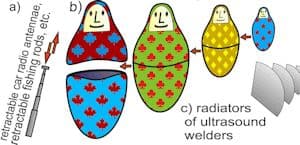 | Modularity, a gain in storage, transport, product variants … |
| #27 | Intermediary | Add an intermediate part or function in the assembly |  | Not the leanest approach. Is that the only solution? |
Adapt To Users or Context
This category regroups all means of changing the product or the system relative to its environment. Mostly at the specification phase rather than later at the design board.
| examples | our comments | |||
#3 | Local quality | adapt the level of quality to the strict required, and only at the required place |  | “Overprocessing” in the 7 wastes of Lean mindset, but for the Design Phase |
| #6 | Universality | Give other usages to an existing part or product |  | Open new markets at very low effort and environmentally friendly. Not exactly to solve a design issue, but upstream. |
| #22 | Benefit From Harm | By lowering, adding, or increasing the harmful factor, make it a beneficial or secondary function | 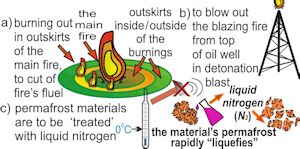 | |
| #23 | Feedback | Adapt actuator to effectively required parameter; control loop |  | Self-leveling & without user intervention. |
| #25 | Self-service | Have the part or product perform other functions, regenerate itself, or produce usable wastes. |  | When possible, a nice way of value added |
| #26 | Copying | Replace complex and costly components with cheap light and simple copies, or work on an image rather than the costly object itself |  | (the essence of value Analyses in case you were not using that already) |
| #27 | Consumables | Replace something strong and costly with consumable parts or components |  | mind the wastes, environment, and new regulations. Other Lean approaches exist |
Forms Follow Functions
One of the motos of this site. Read the corresponding post on Forms Follow Functions (fff): regroups all mean that change the shape or space. Usually, the simplest, most reliable, and most cost-effective solutions.
| examples | our comments | |||
| #8 | Anti-weight | Use the weight to lower other actuators |  | typically the counterweight in an elevator |
| #14 | Spheroidality, Curvature | Make is round | 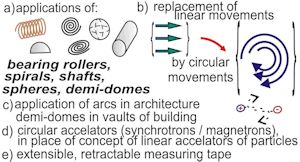 | |
| #17 | Another dimension | made 2D what is 1D, and 3D what is 2D |  | Permits opportunities (gaps, spaces) in the solving |
| #30 | Thin and Flexible | Make heavy structures thin, and eventually flexible if movement is needed | 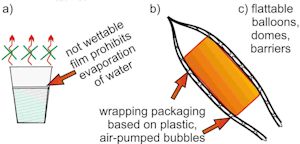 | See the plastic tricks design library for molded hinges or thin walls |
Time Is The Essence
Family regrouping all TRIZ principles function related to time and new sequence.
Because not visible on the drawing board, solving a technical challenge with a new timed sequence can be overlooked
… but beware of not degrading the user experience with longer or additional steps
| examples | our comments | |||
| #9 | Preliminary anti-action | Anticipate the harm with a counteraction | 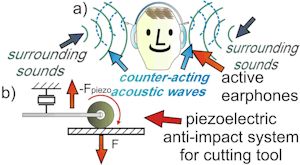 | ex: preload of concrete beams, before the load itself |
| #10 | Preliminary action | Perform in advance the requirement or change or prepare in advance | 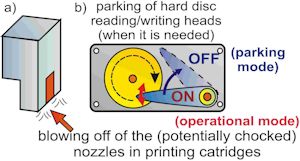 | |
| #11 | Beforehand cushioning | “Prevent rather than cure” before too late |  | Quality, Lean (…) but for design here |
| #13 | The other way round | Invert the physical principle or the parts relative to each other | 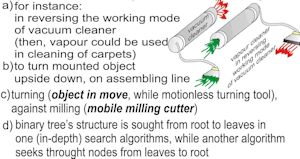 | ex: on a Peltier module, cool one side instead of heating the other |
| #20 | Continuity of useful action | Do not stop the process or movement |  | limit operations and WIP & uses inertia |
| #21 | Rushing Through | Perform the action quick |  | Same logic as applying the force not evenly listed earlier, but on time, to limit the effort, energy, or risk |
| #34 | Discarding and recovering | Use, dispose or reuse at a later time | 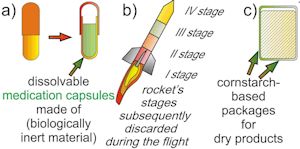 | Environment and production friendly |
Physical Properties
TRIZ Principles which are related to either mechanical, physical, or chemical properties of the materials or the environment.
| examples | our comments | |||
| #12 | Equipotentiality | To conserve energy, limit position changes in a potential field | 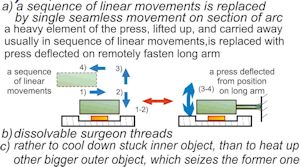 | do not move metal in a magnetic field, or raise parts in a gravity field |
| #15 | Dynamics | Make parts or components move relative to each other | 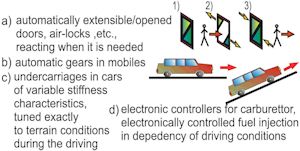 | |
| #16 | Partial or excessive action | Reduce or increase slightly some specs to reach the conform zone |  | Pareto: 20% makes the 80%. Or is 95% enough? |
| #18 | Mechanical vibration | Use vibrations rather than big movements |  | permits very local effect, usually more energy efficient |
| #19 | Periodic action | Replace continuous linear actuators with rotary, pulsating, or repetitive means |  | link to the previous, depending on the magnitude |
| #28 | Mechanics substitution | Replace Mechanics with magnet or electromagnetism |  | Refer to our Design with Magnets post |
| #29 | Pneumatics and hydraulics | Replace Mechanics with Hydraulics system |  | some constraints, but worth every cent when adaptative, flexible, or long distances |
| #31 | Porous materials | Design with porous materials (or increase micro or macro porosity) |  | Lighter. 3D CAD & metal powder sintering helps these days |
| #32 | Color change | Change the color, or transparency to ease the process. Indicate information by a color change. | 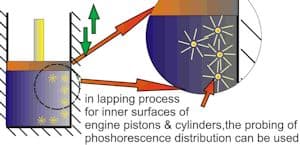 | many special inks or materials are available, for pressure, temperature, density, humidity (…) indication |
| #33 | Homogeneity | Two interacting parts should have the same or similar materials | 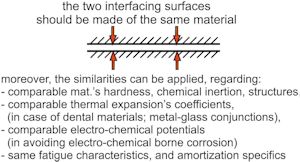 | … and if fixed, be the same part! |
| #35 | Material Properties changes | use change of material properties: physical state change, strength, rigidity, texture, flexibility … |  | (color, length in other principles) |
| #36 | Phases transition | use phase transition consequences: heat absorption or generation, volume change, transparency change … |  | |
| #37 | Thermal expansion | Use material thermal expansion (or contraction) to apply a force |  | Fixed or temporary assemblies. Use bimetals also |
| #38 | Strong oxidants | O2 or O3 enriched atmosphere |  | Mind the flammability & corrosivity aspects |
| #39 | Inert atmosphere | O2 or O3 lowered atmospheres to freeze some chemical reactions | 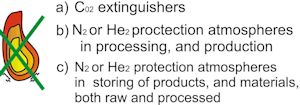 | Opposite of previous; refer to the Triangle of Fire |
| #40 | Composite materials | Use composite materials |  | Lighter. Well-known these days, but mind aging and process repeatability |
Complementary Innovation.world Principles
We felt these complementary principles or technologies were missing in the original 40 TRIZ principles list:

- standardize: both within your production tools and your range of products, but also use OEM and of-the-shelf components (this can hardly be the outcome principle of any patent research, the root of the TRIZ methodology)
- solidified gas or liquid: example: pick-and-place using frozen humidity from the air to pick small components. Some commonalities with #35-Material Properties changes
- impact: to get sudden energy peaks only when needed, rather than increasing the average power (ex: mechanical teeth or roller extractor). Some commonalities with #21-Rushing Through
- nonnewtonian fluids: liquid when still, gets hard when getting energy, stroke, or movement. Used already in the forage industry. With some similarity to the end effect, it can also be a metal powder that solidifies when exposed to a magnetic field as in ferrofluids.
- capillarity: to raise the liquid higher or suck or make visible or mix liquids
- osmosis and inverted osmosis: through a porous membrane to separate ultra-fine elements
- additive materials: various 3D printing technologies, from resins and melted plastics to sintered metal powders
- magnets: not only the electromagnetism mentioned in the list; see the design with magnets dedicated article
- springs, either linear or concentric. To dump movements or energy peaks, but also to store energy and give it back at a later time (one of the TRIZ contradiction solutions: “separate in time”)
Resources of interest for TRIZ Principles
There are plenty of videos on the TRIZ principles, but in this one, Karen Gadd explains the concepts, the real aim, and the context, rather than listing the 40 principles. Check

A presentation with original illustrations for each of the 40 principles:
Full-Size TRIZ Principles Cheat Sheet
